ISSN ONLINE(2319-8753)PRINT(2347-6710)
ISSN ONLINE(2319-8753)PRINT(2347-6710)
| R. SenthilKumar1, M. Loganathana2 E.JamesGunasekaran3 Department of Mechanical Engineering, Annamalai University, Annamalai Nagar, Chidambaram, Tamil Nadu, India1,2,3 |
| Related article at Pubmed, Scholar Google |
Visit for more related articles at International Journal of Innovative Research in Science, Engineering and Technology
Hydrogen is being considered as a primary automotive fuel and as a replacement for conventional fuels. Some of the desirable properties, like high flame velocity, high calorific value motivate to use hydrogen fuel in a dual fuel mode in diesel engine. In this experiment the hydrogen was inducted in the inlet manifold with intake air. The experiments were conducted on a four stroke, single cylinder, water cooled, direct injection (DI), diesel engine at a speed of 1500 rpm. Hydrogen was stored in a high pressure cylinder and supplied to inlet manifold through water and air based flame arrestor. The pressure regulator was used to reduce the cylinder pressure from 140 bar to 2 bar. The hydrogen was inducted with various volume flow rates namely 4lpm, 6lpm and 8lpm respectively by digital volume flow meter. The engine performance, emission and combustion parameters were analyzed at various flow rates of hydrogen and compared with diesel fuel operation. The brake thermal efficiency (BTE) increased and brake specific fuel consumption (BSFC) decreased for hydrogen flow rate of 8lpm as compared to diesel and lower volume flow rate of hydrogen. The hydrocarbon (HC) and carbon monoxide (CO) decreased and the oxides of nitrogen (NOx) increased for higher volume flow rate of hydrogen compared to diesel and lower volume flow rate of hydrogen. The heat release rate and cylinder pressure increased for higher volume flow rate of hydrogen compared to diesel and lower volume flow rate of hydrogen.
Keywords |
| Hydrogen, Diesel, Performance, Emission, Brake Thermal Efficiency |
INTRODUCTION |
| In the modern and fast moving world, petroleum based fuels have become important for a century development. Products derived from crude oil continued to be the major and critical source of energy for fuelling vehicles all over the world. However, petroleum reserves are limited and are non-renewable. During the last decade, the use of alternative fuel in diesel engines has received renewed attention. The uncertainty of petroleum-based fuel availability has created a need for alternative fuels [1]. At the current and projected rate of consumption of crude, it is estimated that these reserves will be badly depleted in due course and it may become impossible to meet the requirements. Diesel engine is the most efficient type of internal combustion engines. In past few decades research efforts have been focused largely on better engine design from the perspective of reducing pollutants emission without sacrificing performance and fuel economy. In recent years, an emphasis on reducing pollutant emissions from petroleum-based engines has motivated the development and testing of several alternative fuels. The main pollutants from diesel engines are NOX (NO—nitric oxide and NO2—nitrogen dioxide), particulate matter and smoke (visible product of combustion) [2]. Various fuels have been considered as substitutes for hydrocarbon-based fuel. Alternative fuels that aspire to replace petroleum-based fuels include alcohols, liquefied petroleum gas (LPG), compressed natural gas (CNG), hydrogen, vegetable oils, bio gas, producer gas and liquefied natural gas (LNG). Of these, hydrogen is a long-term renewable and less-polluting fuel. In addition, hydrogen is non-toxic, odorless and results in complete combustion [3]. Hydrogen can be used as a fuel in internal combustion engines either pure or blended with other hydrocarbon fuels. Due to these characteristics, researchers are focusing attention on hydrogen as an alternative fuel in internal combustion engines (ICEs) and in the development of fuel cell powered vehicles and hybrid electric vehicles (HEVs). Hydrogen can be used as a sole fuel in spark ignition (SI) engine, either by carburation or by direct injection [4]. They also performed an experimental study on burning hydrogen - diesel oil mixture and found that increasing compression ratio is an effective method to improve the combustion characteristics of hydrogen fueled engine. Hydrogen can be commercially produced from electrolysis of water and by coal gasification; it can also be produced by several other methods such as the thermo-chemical decomposition of water and solar photo-electrolysis, although these are currently still in the laboratory stage. Hydrogen fueled ICE vehicles built with current technology are not competitive with synthetic gasoline or methanol vehicles on the basis of coal consumption or fuel cost [5]. The self-ignition temperature of hydrogen is 858 K, so hydrogen cannot be used directly in a CI engine without a spark plug or glow plug. This makes hydrogen unsuitable as a sole fuel for diesel engines [6]. Hydrogen-enriched engines produce approximately the same brake power and higher thermal efficiency than diesel engines over the entire range of operation [7, 8]. With a lesser pilot quantity of diesel, hydrogenenriched engines give higher brake thermal efficiency with smoother combustion than a diesel engine [9]. Hydrogen combustion exhibits higher cooling loss to the combustion chamber wall than does hydrocarbon combustion because of its higher burning velocity and shorter quenching distance [10]. Many researcher have been directed towards the development of alternative fuels to achieve this goal. Among the various probable alternative fuels, hydrogen is found to be the most promising due to its clean burning and better combustion properties. They studied experimentally hydrogen as air enrichment medium with diesel as an ignition source in a stationary diesel engine system to improve engine performance and reduce emissions. However the high self ignition temperature of hydrogen limits its use in compression ignition engines since the cylinder temperature rise due to compression alone is not enough to initiate combustion; hence an ignition source is required. Additionally they found lower hydrocarbons (HC) and (NOx) emission as far as exhaust emission was concerned. Summing up they concluded that the optimal hydrogen enrichment with diesel was 30% [11, 12, 13 and 14]. The results showed less smoke levels and less particulates emission. The results also showed higher brake thermal efficiency and hence lower specific energy consumption. Hydrogen is used in the dual fuel mode with diesel and showed the highest brake thermal efficiency of 30% at a compression ratio of 24.5:1 [15, 16]. The performance of dual injection hydrogen fueled engine by using solenoid in-cylinder injection and external fuel injection technique was also studied. An increase in thermal efficiency by about 22% was noted for dual injection at lowloads and 5% at high loads compared to direct injection [17]. While electrochemically reacting hydrogen in fuel cells is considered to be the cleanest and most efficient means of using hydrogen, it is believed by many to be a technology of the distant future [18]. One of the main obstacles that plagued the successful utilization of hydrogen as a fuel in an ICE has been pre-ignition. This phenomenon is due to the undesirable combustion of the air/fuel charge in the intake manifold [19]. The Combustion duration was reduced due to higher flame speed of hydrogen. Additionally, a higher premixed combustion rate was observed with hydrogen induction [20].The hydrogen engine is a possible solution to improving the engine performance at idle and lean conditions. Since the flame speed of hydrogen is five times as large as that of gasoline, hydrogen engines can get a high degree of constant volume combustion which not only benefits the engine thermal efficiency but also reduces the engine cyclic variation. Additionally, neat diesel was also combusted to compare with the H2/diesel mixture. Results of these tests have compared with data from previous numerical research with different code [21]. Besides, the low ignition energy of hydrogen also permits hydrogen-air mixture to be easily ignited under lean conditions and helps engines gain a smooth starting process. In present work the hydrogen was inducted with air in the inlet manifold with various volume flow rate namely 4lpm, 6lpm and 8lpm. The pilot fuel is diesel. |
| development of fuel cell powered vehicles and hybrid electric vehicles (HEVs). Hydrogen can be used as a sole fuel in spark ignition (SI) engine, either by carburation or by direct injection [4]. They also performed an experimental study on burning hydrogen - diesel oil mixture and found that increasing compression ratio is an effective method to improve the combustion characteristics of hydrogen fueled engine. Hydrogen can be commercially produced from electrolysis of water and by coal gasification; it can also be produced by several other methods such as the thermo-chemical decomposition of water and solar photo-electrolysis, although these are currently still in the laboratory stage. Hydrogen fueled ICE vehicles built with current technology are not competitive with synthetic gasoline or methanol vehicles on the basis of coal consumption or fuel cost [5]. The self-ignition temperature of hydrogen is 858 K, so hydrogen cannot be used directly in a CI engine without a spark plug or glow plug. This makes hydrogen unsuitable as a sole fuel for diesel engines [6]. Hydrogen-enriched engines produce approximately the same brake power and higher thermal efficiency than diesel engines over the entire range of operation [7, 8]. With a lesser pilot quantity of diesel, hydrogenenriched engines give higher brake thermal efficiency with smoother combustion than a diesel engine [9]. Hydrogen combustion exhibits higher cooling loss to the combustion chamber wall than does hydrocarbon combustion because of its higher burning velocity and shorter quenching distance [10]. Many researcher have been directed towards the development of alternative fuels to achieve this goal. Among the various probable alternative fuels, hydrogen is found to be the most promising due to its clean burning and better combustion properties. They studied experimentally hydrogen as air enrichment medium with diesel as an ignition source in a stationary diesel engine system to improve engine performance and reduce emissions. However the high self ignition temperature of hydrogen limits its use in compression ignition engines since the cylinder temperature rise due to compression alone is not enough to initiate combustion; hence an ignition source is required. Additionally they found lower hydrocarbons (HC) and (NOx) emission as far as exhaust emission was concerned. Summing up they concluded that the optimal hydrogen enrichment with diesel was 30% [11, 12, 13 and 14]. The results showed less smoke levels and less particulates emission. The results also showed higher brake thermal efficiency and hence lower specific energy consumption. Hydrogen is used in the dual fuel mode with diesel and showed the highest brake thermal efficiency of 30% at a compression ratio of 24.5:1 [15, 16]. The performance of dual injection hydrogen fueled engine by using solenoid in-cylinder injection and external fuel injection technique was also studied. An increase in thermal efficiency by about 22% was noted for dual injection at lowloads and 5% at high loads compared to direct injection [17]. While electrochemically reacting hydrogen in fuel cells is considered to be the cleanest and most efficient means of using hydrogen, it is believed by many to be a technology of the distant future [18]. One of the main obstacles that plagued the successful utilization of hydrogen as a fuel in an ICE has been pre-ignition. This phenomenon is due to the undesirable combustion of the air/fuel charge in the intake manifold [19]. The Combustion duration was reduced due to higher flame speed of hydrogen. Additionally, a higher premixed combustion rate was observed with hydrogen induction [20].The hydrogen engine is a possible solution to improving the engine performance at idle and lean conditions. Since the flame speed of hydrogen is five times as large as that of gasoline, hydrogen engines can get a high degree of constant volume combustion which not only benefits the engine thermal efficiency but also reduces the engine cyclic variation. Additionally, neat diesel was also combusted to compare with the H2/diesel mixture. Results of these tests have compared with data from previous numerical research with different code [21]. Besides, the low ignition energy of hydrogen also permits hydrogen-air mixture to be easily ignited under lean conditions and helps engines gain a smooth starting process. In present work the hydrogen was inducted with air in the inlet manifold with various volume flow rate namely 4lpm, 6lpm and 8lpm. The pilot fuel is diesel. |
II. MATERIALS AND METHODS |
| 2.1 Production of hydrogen Hydrogen (H2) is only one of many possible alternative fuels that can be derived from natural resources such as coal, oil shale and uranium (or) from renewable resources [2]. H2 can be commercially produced from electrolysis of water and also by coal gasification. Several other methods such as thermo chemical decomposition of water and solar photo electrolysis are available, but presently used at the laboratory level rather than for commercial use. The H2 fueled vehicles that could be built with current technology are not competitive with synthetic gasoline or methanol vehicles on the basis of fuel consumption or fuel cost. However, with the development of practical and highly efficient end-use converters of H2 such as fuel cells, there will be a dramatic reduction in cost and improvement in efficiency of H2 production, safe and convenient on board storage. |
2.2 Combustion and Properties of Hydrogen |
| Hydrogen on burning produces only water. It is non-toxic, non-odorant and also results in complete combustion. Hydrogen has a high self-ignition temperature (858ºK); therefore it is difficult to ignite hydrogen with help of only compression. Due to this property, hydrogen cannot be used in a diesel engine system without an ignition source. So to start combustion some ignition source is required during the compression stroke. Before TDC a small charge of diesel fuel is injected through the conventional injection system which acts as a source of ignition. Combustion of hydrogen is fundamentally different from the combustion of hydrocarbon fuel. Hydrogen has wider flammability limits of 4–75% by volume in air compared to diesel fuel which is 0.7–5% by volume. The burning velocity is so high that very rapid combustion can be achieved. The limit of flammability of hydrogen varies from an equivalence ratio of 0.1 to 7.1. Hydrogen at Ordinary temperature and pressure is a light Gas with a density of only 1/14th that of air and 1/9th that of natural gas. By cooling to the extreme temp of 253 degrees at atmospheric pressure, the gas is condensed to a liquid with a specific gravity of 0.07. The standard heating value of Hydrogen gas is 12.1 MJ/Cum compared with the average of 38.3 MJ/Cu m for natural gas. The Flame Speed of Hydrogen burning in the air is such greater than the natural gas, and the energy required to initiate the combustion is less. Mixture of hydrogen and air or combustible over an exceptionally wide range of compositions the flammability limits at ordinary temperatures extend from 4% to 74% by volume of hydrogen in air. The table.1 gives the various properties of hydrogen at 25ºC and 1 atm. |
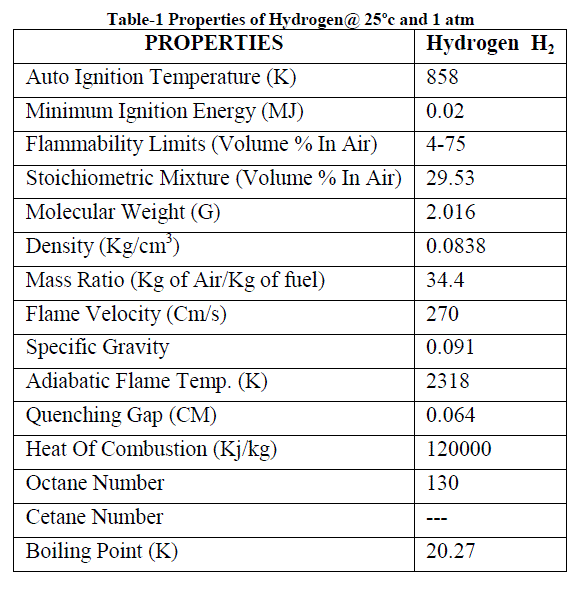 |
| 2.3. Uncertainty analysis Any experimental measurements, irrespective of the type of instrument used, possess some uncertainty. The uncertainty of any measurement may be due to fixed or random errors. As fixed errors are repeatable, they can be easily accounted for to get the true value of the measurement. However, random errors must be estimated analytically. Percentage uncertainties of various parameters such as brake power, brake-specific fuel consumption and BTE were calculated using the percentage uncertainties of various instruments used in the experiment. The typical values of errors of various parameters are given in Table 2. |
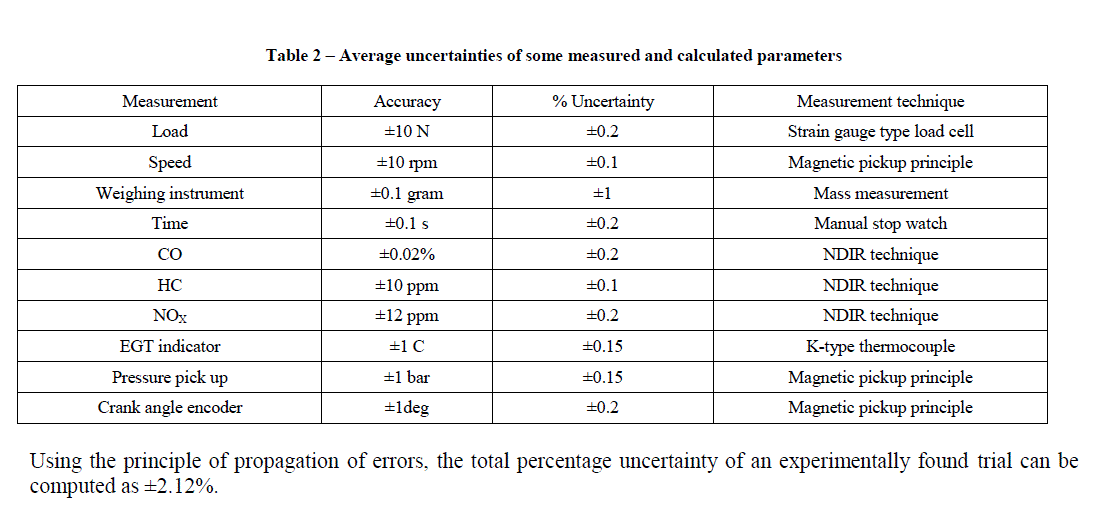 |
III. EXPERIMENTAL SETUP AND PROCEDURE |
| The schematic and photographic view of the experimental setup are shown in Fig. 1 and fig.2 respectively. |
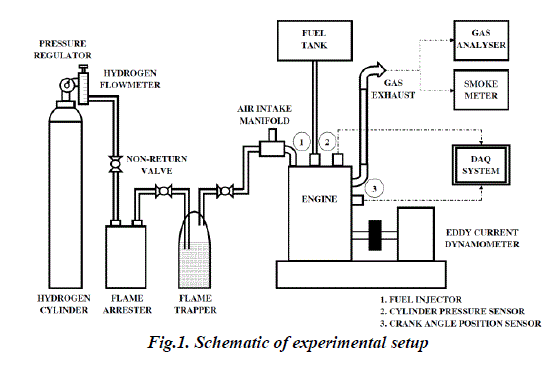 |
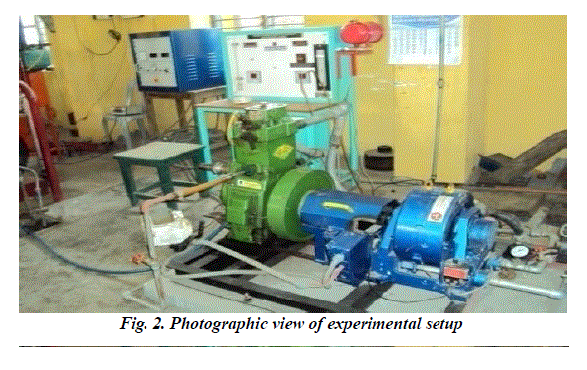 |
| Experiments were conducted in a single cylinder, four stroke, water-cooled, diesel engine (Make: Kirloskar AV-1). The engine was coupled to an eddy current dynamometer. The engine was run at a constant speed of 1500 rpm. The specifications of the engine used are given in Table 3. |
 |
| A crank angle encoder was fitted to the crank shaft to measure the crank angle. The cylinder pressure was measured by a piezoelectric pressure transducer (Make: Kistler, Type 6056A) mounted on the cylinder head. The pressure signal was sent to data acquisition system and combustion data like cylinder pressure and heat release rate (HRR) were obtained. The oxides of nitrogen (NOx), carbon monoxide (CO) and hydrocarbon (HC) emissions were measured with nondispersive infrared analyzers (NDIR) (Make: HORIBA-Japan). The gas analyzers were calibrated with standard gases before test. Initially, the engine was operated with neat diesel fuel to obtain reference data. Further, the engine was tested with dual fuel mode like addition of hydrogen with inlet air in addition to pilot diesel injection. The hydrogen gas was inducted in the inlet manifold in different flow rate namely 4lpm, 6lpm and 8 lpm respectively. The hydrogen flow line consists of hydrogen cylinder, pressure regulator, flame arrester, flow meter and flow control valve shown in figure.1. |
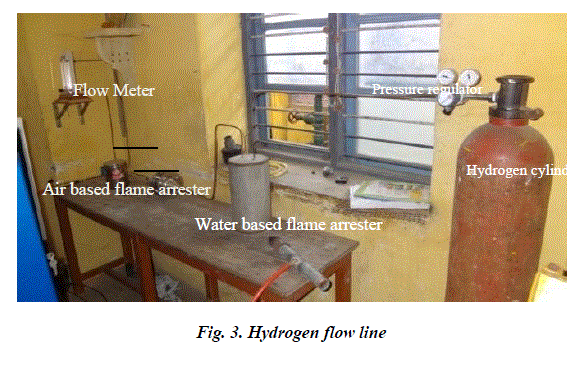 |
| The pressure of hydrogen stored in a high-pressure storage tank was reduced from 250 bar to a pressure 2 bar using a pressure regulator. Hydrogen was then passed through a flame arrestor and flame trap which arrest any backfire of the engine. It also acts as a non return valve. Then the hydrogen is passed through the digital gas flow meter, of range 0–10 lpm. The combustion, performance and emission characteristics were evaluated for different hydrogen flow rates and compared with neat diesel fuel operation. |
IV. RESULTS AND DISCUSSION |
| 4.1 Performance analysis 4.1.1 Brake Thermal Efficiency Fig. 4 shows the variation in brake thermal efficiency with brake power for different flow rates of hydrogen. The 8 lpm hydrogen addition gives the highest brake thermal efficiency (39.42%) compared to diesel (35.21%) at full load. The brake thermal efficiency increases with higher hydrogen enrichment. The increase in brake thermal efficiency is due to hydrogen’s higher calorific value and better mixing with air in addition to its faster burning rate characteristics [22]. It was observed that the hydrogen addition with inlet air showed the improved performance compared to normal neat diesel operation. |
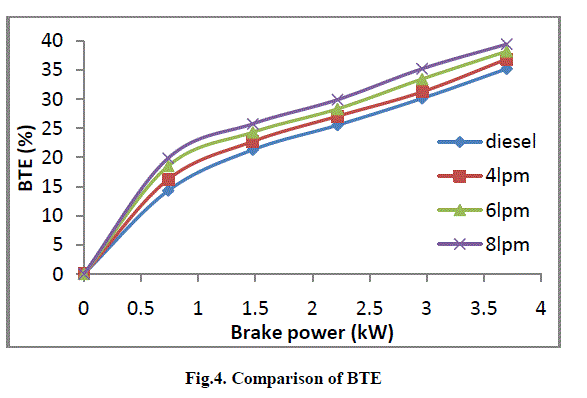 |
| 4.1.2. Brake Specific Fuel Consumption Fig. 5 shows the variation of brake specific fuel consumption (BSFC) with brake power for different flow rates of hydrogen. The BSFC decreases with an increase in hydrogen addition rate with air. The lowest BSFC of 0.21kJ/kW-hr is obtained for 8lpm hydrogen enrichment at 3.7 kW compared to diesel of 0.31kJ/kW-hr. This is due to the premixing of hydrogen fuel with air due to its high diffusivity and uniform mixing with air resulting in improved combustion. The percentage of reduction of BSFC was observed 32% at full load between diesel and 8 lpm hydrogen flow rate. |
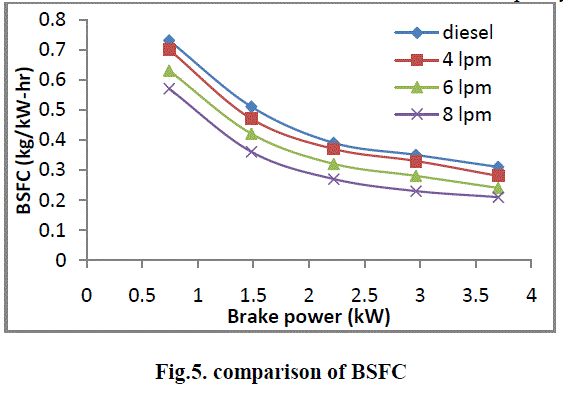 |
| 4.2 Emission analysis 4.2.1. Nitrogen Oxides (NOx) Fig. 6 shows the variation of nitrogen oxides emissions with load. NOX forms at peak combustion temperature and higher oxygen concentrations [23,24]. NOX formation is higher with 8 lpm compared to neat diesel and other flow rates of hydrogen. As the hydrogen percentage increases, the flame speed and hence combustion efficiency increased [25]. The percentage of increase of NOX is 25% at full load compared neat diesel. |
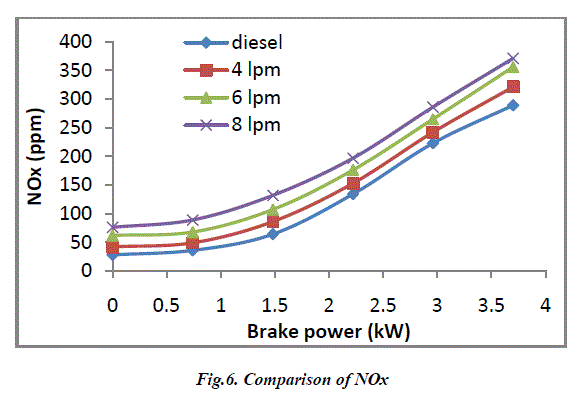 |
| 4.2.2. Hydrocarbon (HC) Unburned hydrocarbon decreases significantly because hydrogen fuel does not contain carbon. The variation of HC emissions with Brake power for different values of hydrogen enrichment is shown in fig 7. It is observed that the HC emission values of 4 lpm, 6 lpm and 8 lpm hydrogen flow rate with diesel fuel operation are 90 ppm, 92 ppm and 87 ppm respectively at full load. The lowest HC emission obtained was 87 ppm with 8 lpm hydrogen flow rate compared to 94 ppm for diesel. The reduction in HC is due to the higher burning velocity of hydrogen, that enhances the diesel burning. The absence of carbon in hydrogen fuel also reduces the HC emissions to a greater extent [25, 26]. There are similar results reported in previous in previous studies [27]. |
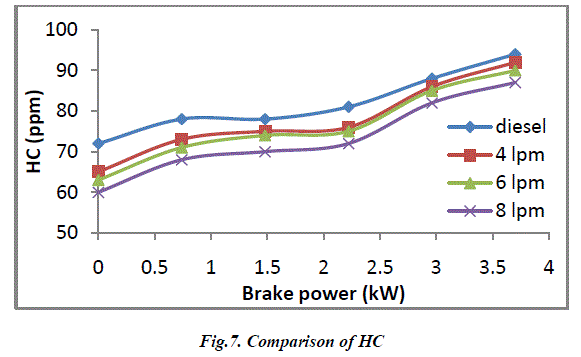 |
| 4.2.3 Carbon monoxide The variation of carbon monoxide with engine brake power and different proportion of hydrogen enrichment is shown fig 8.The lowest CO emission was obtained as 0.044% with 8 lpm when compared to 0.05% for diesel. With 8 lpm the CO emission is lower than other hydrogen flow rates and neat diesel operation. The reduction CO in 8 lpm hydrogen- operated dual fuel engine is due to the absence of carbon in hydrogen fuel. At no load since the engine is operated at lean equivalence ratio, a reduction in CO is observed for hydrogen dual fuel operation. But the oxygen concentration reduces significantly and in addition due to lesser reaction time it results in a significant increase in CO formation rate, that makes the overall CO concentration to increase at full load compared to diesel |
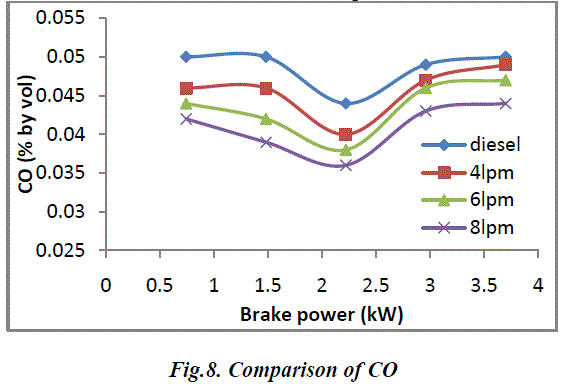 |
| 4.2.4 Exhaust gas temperature The variation of exhaust gas temperature with brake power and different proportions of hydrogen enrichment is shown in Fig 9. It is observed that the exhaust gas temperate value of 4 lpm, 6 lpm and 8 lpm hydrogen and diesel fuel operation increased averagely compared to diesel at, full load respectively. The highest exhaust temperature 467 °C with 8 lpm hydrogen addition compared to 425 °C for diesel. This is due to better mixing of hydrogen with air resulting in complete combustion of fuel with the increase in temperature around the combustion chamber. [28]. |
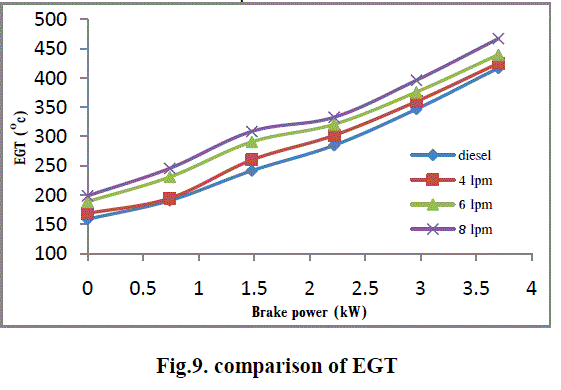 |
| 4.3 Combustion analysis 4.3.1 Cylinder Pressure Fig. 10 shows the variation of cylinder pressure with crank angle. It is observed that hydrogen (8 lpm) and diesel fuel mode gives a higher peak pressure compared to diesel fuel operation at full load. With diesel, the peak pressure is 66.60 bar and with hydrogen 68.58bar peak pressure. The peak pressure for hydrogen occurs 5ºCA later than that of diesel. The pressure rise is always lower in the case of diesel operation due to its slower burning characteristics [29]. |
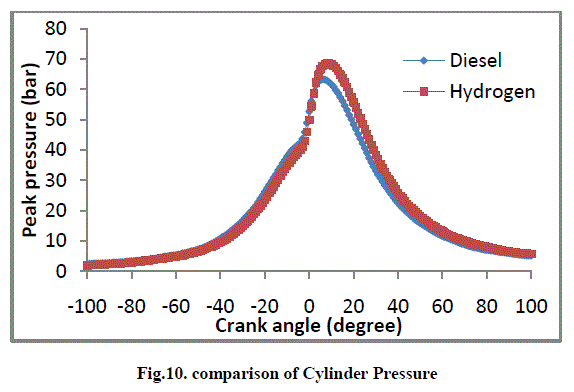 |
| 4.3.2. Heat release rate (HRR) Fig. 11 depicts the variation of heat release rate for hydrogen diesel combustion with 8 lpm hydrogen enrichment at full load. It is evident that heat release for hydrogen is more rapid than for diesel. The ignition of hydrogen with 8 lpm hydrogen enrichment operation takes place only after injection of diesel at 23º bTDC. It can also be observed that the highest heat release rate is 52.79 J/deg CA for 8 lpm hydrogen enrichment compared to neat diesel value of 48.84 J/deg CA. This is due to the instantaneous combustion (constant volume) that takes place with hydrogen fuel. The premixed fuel burns rapidly and releases an enormous amount of heat followed by the controlled heat release. The HRR during the premixed combustion is responsible for the high peak pressure [30, 31]. |
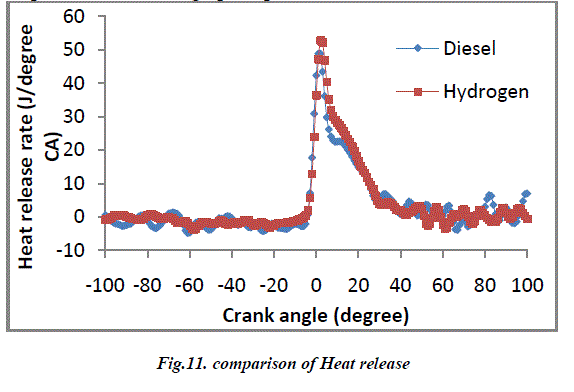 |
V. CONCLUSIONS |
| Based on the experiments conducted on a hydrogen-enriched air-inducted diesel (dual fuel) engine system, the following conclusions are drawn:• The Brake thermal efficiency of the hydrogen with diesel fuel operation was quite higher than the diesel fuel operation over the entire brake power range. In 8 lpm flow rate of hydrogen brake thermal efficiency is increased due to addition of hydrogen fuel.• Brake Specific fuel consumption decreases with increase in hydrogen percentage over the entire range of operation. |
| ïÃâ÷ NOx concentration increases with higher enrichment of hydrogen (8lpm) compared to lower hydrogen enrichment and diesel.• The Carbon monoxide emission decreased at part load and increased in full load condition. The lowest CO emission was obtained 0.044 vol. % with 8 lpm hydrogen addition, compared to 0.05% for diesel.• The HC emission for all additional hydrogen rates decreased averagely compared to diesel at full load, respectively.The lowest HC emission was obtained 87 ppm with 8 lpm addition hydrogen with diesel , compared to 94 ppm for neat diesel.• The Exhaust gas temperature increased for all additional hydrogen flow rates averagely compared to diesel at full load, respectively.• The Cylinder pressure increased for 8 lpm hydrogen flow rates compared to neat diesel at full load, respectively.• HRR are higher for 8 lpm hydrogen flow rates compared to neat diesel fuel. The HRR for 8lpm hydrogen flow rate is 52.79 J/deg and 48.84 J/deg CA for neat diesel fuel at full load. On the whole it was concluded that hydrogen-enriched diesel engines perform well and emit less pollution compared to neat diesel fuel. Hence, hydrogen enrichment in a CI engine can be regarded as an eco-friendly alternative fuel to sole diesel. |
References |
|